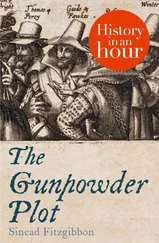John Gerard - What was the Gunpowder Plot? The Traditional Story Tested by Original Evidence
Здесь есть возможность читать онлайн «John Gerard - What was the Gunpowder Plot? The Traditional Story Tested by Original Evidence» — ознакомительный отрывок электронной книги совершенно бесплатно, а после прочтения отрывка купить полную версию. В некоторых случаях можно слушать аудио, скачать через торрент в формате fb2 и присутствует краткое содержание. Жанр: foreign_antique, foreign_prose, на английском языке. Описание произведения, (предисловие) а так же отзывы посетителей доступны на портале библиотеки ЛибКат.
- Название:What was the Gunpowder Plot? The Traditional Story Tested by Original Evidence
- Автор:
- Жанр:
- Год:неизвестен
- ISBN:нет данных
- Рейтинг книги:5 / 5. Голосов: 1
-
Избранное:Добавить в избранное
- Отзывы:
-
Ваша оценка:
- 100
- 1
- 2
- 3
- 4
- 5
What was the Gunpowder Plot? The Traditional Story Tested by Original Evidence: краткое содержание, описание и аннотация
Предлагаем к чтению аннотацию, описание, краткое содержание или предисловие (зависит от того, что написал сам автор книги «What was the Gunpowder Plot? The Traditional Story Tested by Original Evidence»). Если вы не нашли необходимую информацию о книге — напишите в комментариях, мы постараемся отыскать её.
What was the Gunpowder Plot? The Traditional Story Tested by Original Evidence — читать онлайн ознакомительный отрывок
Ниже представлен текст книги, разбитый по страницам. Система сохранения места последней прочитанной страницы, позволяет с удобством читать онлайн бесплатно книгу «What was the Gunpowder Plot? The Traditional Story Tested by Original Evidence», без необходимости каждый раз заново искать на чём Вы остановились. Поставьте закладку, и сможете в любой момент перейти на страницу, на которой закончили чтение.
Интервал:
Закладка:
At the same time it appears highly probable that he was similarly in the pay of France. Ibid.
42
Queen Elizabeth regarded as treasonable any discussion of the question of the succession.
43
Gardiner, i. 215.
44
Chamberlain to Carleton , July 9th, 1612, R.O.
45
"Tout ce que vous a dit le Comte de Salisbury touchant le mariage d'Espagne est rempli de deguisements et artifices à son accoutumée… Toutefois, je ne veux pas jurer qu'ils négocient plus sincerement et de meilleur foi avec lesdites Espagnols qu'avec nous. Ils corromproient par trop leur naturel, s'ils le faisoient, pour des gens qui ne leur scauroient guère de gré." – Le Fèvre de la Boderie, Ambassade , i. 170.
46
(Of the Earl of Northumberland.) "On tient le Comte de Salisbury pour principal auteur de sa persécution, comme celui qui veut ne laisser personne en pied qui puisse lui faire tête." De la Boderie. Ibid. 178.
47
R.O. Dom. James I. lxix. 56.
48
Ibid. , May 27, 1612. Bishop Goodman, no enemy of Cecil, is inclined to believe that at the time of the secretary's death there was a warrant out for his arrest. Court of King James , i. 45.
49
The first of these epigrams, in Latin, concludes thus:
Sero, Recurve, moreris sed serio;
Sero, jaces (bis mortuus) sed serio:
Sero saluti publicæ, serio tuæ.
The second is in English:
Whiles two RR's, both crouchbacks, stood at the helm,
The one spilt the blood royall, the other the realm.
A marginal note explains that these were, "Richard Duke of Gloster, and Robert Earl of Salisburie;" the anagram, of which title is "A silie burs." He also styles the late minister a monkey ( cercopithecus ) and hobgoblin ( empusa ).
50
Osborne, Traditional Memoirs , p. 236 (ed. 1811).
51
Court of King James , i. 44.
52
Traditional Memoirs , 181.
53
This feeling was expressed in lampoons quoted by Osborne, e.g.:
"Here lies Hobinall, our pastor while here,
That once in a quarter our fleeces did sheare.
For oblation to Pan his custom was thus,
He first gave a trifle, then offer'd up us:
And through his false worship such power he did gaine,
As kept him o' th' mountain, and us on the plaine."
Again, he is described as
"Little bossive Robin that was so great,
Who seemed as sent from ugly fate,
To spoyle the prince, and rob the state,
Owning a mind of dismall endes,
As trappes for foes, and tricks for friends."
( Ibid. 236.)
Oldmixon ( History of Queen Elizabeth , p. 620) says of the Earl of Essex, "'Twas not likely that Cecil, whose Soul was of a narrow Size, and had no Room for enlarged Sentiments of Ambition, Glory, and Public Spirit, should cease to undermine a Hero, in comparison with whom he was both in Body and Mind a Piece of Deformity, if there's nothing beautiful in Craft."
54
Court and Character of King James , § 10.
55
Ambassade , i. 58.
56
Ibid. 401.
57
Against Northumberland nothing was proved ( vide de la Boderie, Ambassade , i. 178), except that he had admitted Thomas Percy amongst the royal pensioners without exacting the usual oath. He in vain demanded an open trial, but was prosecuted in the Star Chamber, and there sentenced to a fine of £30,000 (equal to at least ten times that sum in our money), and to be imprisoned for life.
Mr. Gardiner considers that, in regard both of Raleigh and of Northumberland, Cecil acted with great moderation. It must, however, be remembered that in his secret correspondence with King James, before the death of the queen, he had strenuously endeavoured to poison the mind of that monarch against these his rivals. Thus he wrote, December 4th, 1601 (as usual through Lord Henry Howard): "You must remember that I gave you notice of the diabolical triplicity, that is, Cobham, Raleigh, and Northumberland, that met every day at Durham-house, where Raleigh lies, in consultation, which awaked all the best wits of the town … to watch what chickens they could hatch out of these cockatrice eggs that were daily and nightly sitten on." ( Secret Correspondence of Sir Robert Cecil with James VI., King of Scotland , Edinburgh, 1766, p. 29.) Coming after this, the speedy ruin of all these men appears highly suspicious.
58
Sir Walter Cope in his Apology (Gutch, Collectanea Curiosa , i. No. 10) says: "When living, the world observed with all admiration and applause; no sooner dead, but it seeketh finally to suppress his excellent parts, and load his memory with all imputations of corruption."
Among such charges are enumerated "His Falsehood in Friendship. – That he often made his friends fair promises, and underhand laid rubs to hinder their preferment. – The secret passage of things I know not… Great Counsellors have their private and their publique ends…" etc.
59
Lord Castlemaine after mentioning the chief features of the Gunpowder Plot, goes on: "But let it not displease you, if we ask whether Ulysses be no better known?" ( Catholique Apology , p. 30.)
Francis Herring in his Latin poem, Pietas Pontificia (published 1606), speaking of Monteagle (called "Morleius," from his father's title), who took the celebrated letter to Cecil, writes thus:
"Morleius Regis de consultoribus unum,
(Quem norat veteri nil quicquam cedere Ulyssi,
Juditio pollentem acri, ingenioque sagaci)
Seligit, atque illi Rem totam ex ordine pandit."
60
This is so evident that it appears unnecessary to occupy space with proofs in detail. De la Boderie remarks ( Ambassade , i. 71) on the extraordinary rancour of the minister against Catholics, and especially against Jesuits, and that "he wishes to destroy them everywhere." Of this a remarkable confirmation is afforded by the instructions given to Sir Thomas Parry when he was sent as ambassador, "Leiger," to Paris, in 1603, at the head of which stood these extraordinary articles:
1. "To intimate to the French king the jealousy conceived in England upon the revocation of the Jesuits, against former edicts.
2. "To inform the French king that the English were disgusted at the maintenance allowed to the French king's prelates and clergy, to priests and Jesuits that passed out of his dominions into England, Scotland, and Ireland, to do bad offices." (P.R.O. France , bundle 132, f. 314.)
61
Jardine, Gunpowder Plot , p. 5. Strype says of the time of Elizabeth: "The faction of the Catholics in England is great, and able, if the kingdom were divided into three parts, to make two of them." ( Annals , iii. 313, quoted by Butler, Historical Memoirs , ii. 177.)
At the execution of Father Oldcorne, 1606, a proof was given of their numbers which is said to have alarmed the king greatly. The Father having from the scaffold invited all Catholics to pray with him, almost all present uncovered.
62
Of this there can be no doubt, in spite of James's subsequent denial. Father Garnet wrote to Parsons (April 16th, 1603): "There hath happened a great alteration by the death of the Queen. Great fears were, but all are turned into greatest security, and a golden time we have of unexpected freedom abroade… The Catholicks have great cause to hope for great respect, in that the nobility all almost labour for it, and have good promise thereof from his Majesty." (Stonyhurst MSS. Anglia , iii. 32.)
Читать дальшеИнтервал:
Закладка:
Похожие книги на «What was the Gunpowder Plot? The Traditional Story Tested by Original Evidence»
Представляем Вашему вниманию похожие книги на «What was the Gunpowder Plot? The Traditional Story Tested by Original Evidence» списком для выбора. Мы отобрали схожую по названию и смыслу литературу в надежде предоставить читателям больше вариантов отыскать новые, интересные, ещё непрочитанные произведения.
Обсуждение, отзывы о книге «What was the Gunpowder Plot? The Traditional Story Tested by Original Evidence» и просто собственные мнения читателей. Оставьте ваши комментарии, напишите, что Вы думаете о произведении, его смысле или главных героях. Укажите что конкретно понравилось, а что нет, и почему Вы так считаете.












